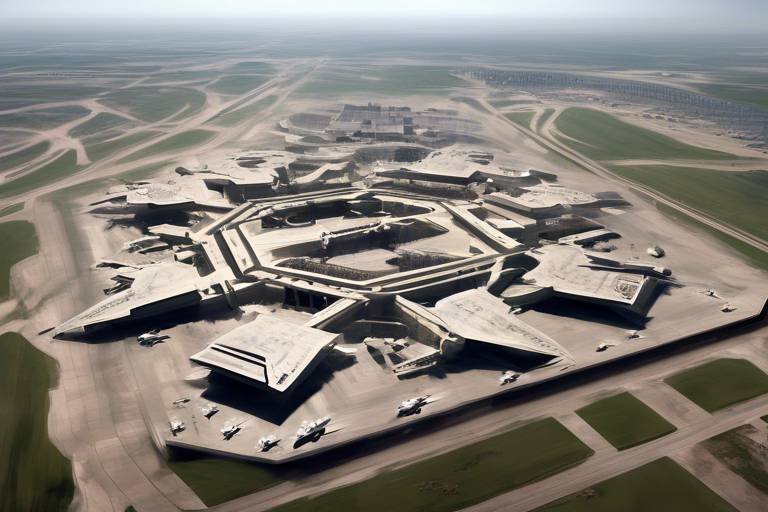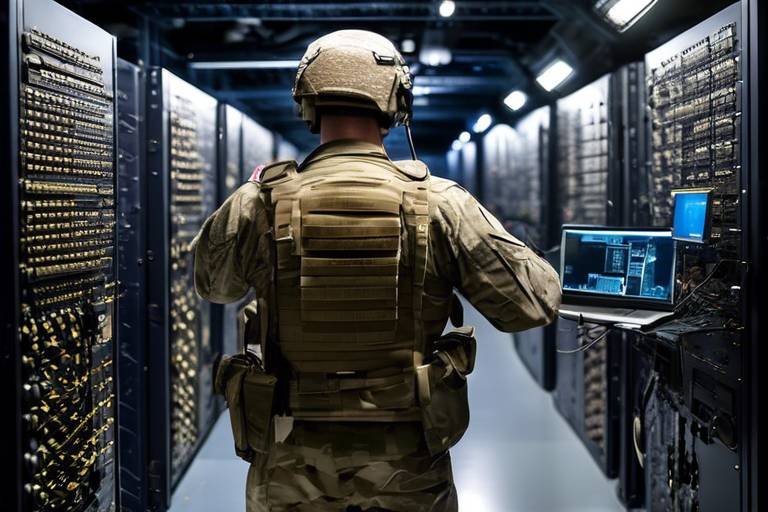AI in Military Supply Chains - The Next Frontier in Logistics
The integration of artificial intelligence (AI) into military supply chains is not just a trend; it's a revolution. Imagine a world where logistics operations are as seamless as a well-oiled machine, where every component, from inventory management to transportation, operates with pinpoint accuracy. This is the promise of AI in military logistics. By harnessing the power of AI, military organizations can enhance their operational efficiency, reduce costs, and improve decision-making processes. It's akin to having a supercharged assistant that not only predicts needs but also adapts to sudden changes in the battlefield environment.
As we delve deeper into this transformative technology, it's essential to understand how AI can optimize logistics. The military operates in dynamic environments where the stakes are incredibly high. Every second counts, and the ability to respond swiftly to changing circumstances can mean the difference between mission success and failure. With AI, military supply chains are evolving into systems that are not only reactive but also proactive. They can anticipate challenges, forecast demand, and manage resources with an unparalleled level of precision.
Furthermore, the role of data in this equation cannot be overstated. Military logistics generate vast amounts of data daily, and AI excels at processing and analyzing this information. By leveraging predictive analytics, military leaders can gain insights into potential supply chain disruptions before they occur. This foresight allows for timely interventions, ensuring that troops have the necessary resources when they need them the most.
AI also enhances visibility across the supply chain. Imagine being able to track every piece of equipment and supply in real-time, knowing exactly where it is and when it will arrive. This level of transparency fosters better coordination among various military units, minimizing delays and ensuring that all components are aligned with mission objectives. The result? A more agile and responsive military force capable of adapting to the ever-changing landscape of modern warfare.
However, it's important to acknowledge that the journey towards integrating AI into military logistics is not without its challenges. Issues such as cybersecurity risks and the need for robust infrastructure can pose significant hurdles. As military organizations increasingly rely on AI systems, safeguarding sensitive data becomes paramount. Advanced protective measures must be in place to mitigate potential threats and ensure the integrity of military operations.
Moreover, the implementation of AI solutions requires substantial investments in both infrastructure and training. For some military organizations, these requirements can be daunting. Nevertheless, the long-term benefits of embracing AI far outweigh the initial challenges. As we continue to explore the potential of AI in military supply chains, one thing is clear: the future of military logistics is here, and it’s powered by artificial intelligence.
- What is AI's role in military supply chains? AI optimizes logistics processes by improving inventory management, demand forecasting, and real-time monitoring.
- How does predictive analytics enhance military logistics? It allows military supply chains to anticipate needs and challenges, ensuring timely responses to dynamic operational environments.
- What challenges does AI face in military logistics? Key challenges include cybersecurity risks and the need for significant investments in infrastructure and training.

The Role of AI in Logistics Optimization
Artificial Intelligence (AI) is revolutionizing the way military logistics operates, and its role in logistics optimization cannot be overstated. Imagine a world where every logistical decision is backed by data, where inventory levels are managed with precision, and where demand forecasting is so accurate that it feels almost prophetic. This is not science fiction; it's the reality that AI brings to military supply chains. By leveraging advanced algorithms and machine learning techniques, military organizations can dramatically enhance their operational efficiency.
One of the most significant contributions of AI in logistics is its ability to optimize inventory management. Traditional inventory systems often struggle with inaccuracies and delays, which can lead to overstocking or stockouts. However, AI analyzes historical data, current trends, and even external factors like weather conditions or geopolitical events to provide real-time insights. This data-driven approach allows military logistics teams to maintain optimal inventory levels, ensuring that supplies are available when and where they are needed most.
Moreover, AI’s predictive capabilities extend to demand forecasting, which is crucial for military operations. The unpredictability of military engagements means that supply chains must be agile and responsive. AI can assess various data points to predict future supply needs, allowing logistics personnel to prepare in advance. For example, if a military operation is expected to escalate, AI can suggest ramping up supply orders to meet the anticipated demand. This proactive strategy minimizes delays and enhances readiness on the ground.
Let’s not forget about the efficiency gains from AI-driven automation. By automating repetitive tasks such as order processing, inventory tracking, and shipment scheduling, military logistics teams can focus their efforts on more strategic initiatives. This means that personnel can allocate their time to planning and executing operations rather than being mired in mundane tasks. In essence, AI acts as a force multiplier, enhancing human capabilities and optimizing resource allocation.
To illustrate the impact of AI on logistics optimization, consider the following table that summarizes key benefits:
| Benefit | Description |
|---|---|
| Enhanced Inventory Management | AI ensures optimal stock levels by analyzing real-time data. |
| Accurate Demand Forecasting | Predictive analytics help anticipate supply needs based on various factors. |
| Increased Operational Efficiency | Automation of routine tasks allows personnel to focus on strategic planning. |
| Improved Decision-Making | Data-driven insights enable informed choices, reducing risks. |
In conclusion, the role of AI in logistics optimization is pivotal for military supply chains. By harnessing the power of AI, military organizations can not only improve efficiency and accuracy but also enhance their overall operational readiness. As we move forward, the integration of AI technologies will likely become even more critical, paving the way for smarter, more resilient military logistics systems.
- What are the main benefits of AI in military logistics? AI enhances inventory management, improves demand forecasting, increases operational efficiency, and supports data-driven decision-making.
- How does predictive analytics work in military supply chains? Predictive analytics uses historical and real-time data to forecast future supply needs, allowing for proactive resource management.
- What challenges does AI face in military logistics? Key challenges include cybersecurity risks, the need for robust infrastructure, and the requirement for training personnel to effectively use AI tools.

Predictive Analytics for Supply Chain Management
In the ever-evolving landscape of military logistics, predictive analytics emerges as a game-changer. Imagine having the ability to foresee potential supply chain disruptions before they even occur. This is not science fiction; it's the power of AI-driven predictive analytics. By analyzing historical data and identifying patterns, military supply chains can better anticipate needs, allowing for proactive rather than reactive strategies. This capability is crucial in dynamic operational environments where every second counts.
One of the most significant advantages of predictive analytics is its ability to enhance demand forecasting. By leveraging algorithms that sift through vast amounts of data, military logistics teams can predict what supplies will be needed and when. This not only minimizes the risk of shortages but also helps in managing inventory more efficiently. For instance, if a specific unit is preparing for an operation in a remote area, predictive analytics can suggest the optimal amount of supplies required based on similar past missions, ensuring that troops are well-equipped without overstocking resources.
Furthermore, predictive analytics can identify potential challenges that may arise during operations. For example, it can analyze weather patterns, transportation routes, and even geopolitical factors that could impact supply chain logistics. By doing so, military planners can create contingency plans that address these challenges head-on, ensuring that they are always one step ahead. This level of foresight not only enhances operational readiness but also significantly reduces costs associated with last-minute supply chain adjustments.
To illustrate the impact of predictive analytics, consider the following table that highlights key areas of improvement:
| Area of Improvement | Traditional Approach | With Predictive Analytics |
|---|---|---|
| Demand Forecasting | Reactive, based on historical data | Proactive, using real-time data analysis |
| Inventory Management | Static, often leading to shortages or overstock | Dynamic, optimizing stock levels based on predictions |
| Operational Challenges | Addressed as they arise | Anticipated and mitigated in advance |
In conclusion, the integration of predictive analytics into military supply chain management is not just beneficial; it is essential. By harnessing the power of data, military organizations can ensure that they are prepared for any scenario, ultimately leading to enhanced operational effectiveness and mission success. The future of military logistics is here, and it is powered by predictive analytics.
- What is predictive analytics? Predictive analytics involves using statistical algorithms and machine learning techniques to identify the likelihood of future outcomes based on historical data.
- How does predictive analytics improve military logistics? It enhances demand forecasting, optimizes inventory management, and allows for proactive planning to mitigate potential challenges.
- Are there challenges in implementing predictive analytics? Yes, challenges include data quality, integration with existing systems, and the need for skilled personnel to interpret data.

Data-Driven Decision Making
In the world of military logistics, the ability to make informed decisions can mean the difference between mission success and failure. This is where comes into play. By harnessing the power of artificial intelligence, military logistics teams can analyze vast amounts of data to derive actionable insights. Imagine having a tool that not only processes information at lightning speed but also learns from past decisions to improve future outcomes. That's the magic of AI in military supply chains!
The integration of AI into decision-making processes allows military personnel to shift from reactive strategies to proactive planning. For instance, AI algorithms can analyze historical data trends, operational conditions, and even weather patterns to predict supply needs accurately. This predictive capability ensures that resources are allocated efficiently, minimizing waste and maximizing operational readiness.
Moreover, the use of AI in data analysis helps to identify potential risks before they escalate into significant issues. By continuously monitoring supply chain performance and external factors, military logistics teams can anticipate challenges and adjust their strategies accordingly. This level of foresight is akin to having a crystal ball—one that enables commanders to make decisions with greater confidence and clarity.
To illustrate the impact of data-driven decision making, consider the following table that highlights the benefits of integrating AI into military logistics:
| Benefit | Description |
|---|---|
| Enhanced Accuracy | AI algorithms analyze data to provide precise demand forecasts, reducing the risk of shortages or surplus. |
| Improved Efficiency | Automated data analysis speeds up decision-making processes, allowing for quicker responses to changing conditions. |
| Risk Mitigation | Proactive identification of potential disruptions enables timely interventions, safeguarding mission objectives. |
| Resource Optimization | Data-driven insights lead to better allocation of resources, ensuring that every asset is utilized effectively. |
In conclusion, the shift towards data-driven decision making in military logistics is not just a trend; it is a revolution that empowers military leaders to make smarter, faster, and more effective decisions. With AI at the helm, the days of guesswork are behind us. Instead, we are stepping into an era where every decision is informed by data, ensuring that military operations are as efficient and effective as possible.
- What is data-driven decision making?
Data-driven decision making involves using data analysis and AI to inform and guide strategic decisions in logistics. - How does AI improve military logistics?
AI enhances military logistics by providing predictive analytics, improving accuracy, and optimizing resource allocation. - What are the challenges of implementing AI in military logistics?
Challenges include cybersecurity risks, the need for robust infrastructure, and training personnel to effectively use AI tools.

Real-Time Monitoring and Adjustments
In the rapidly evolving world of military logistics, real-time monitoring and adjustments have become crucial for operational success. Imagine being in a high-stakes game where every second counts; this is the reality for military supply chains. With the integration of artificial intelligence, logistics teams can now track inventory levels, delivery statuses, and supply chain performance in real-time. This capability not only enhances visibility but also allows for swift decision-making that can mean the difference between mission success and failure.
AI systems continuously analyze data streams from various sources, such as transportation vehicles, warehouses, and suppliers. This constant flow of information enables logistics personnel to identify potential bottlenecks or disruptions before they escalate into serious problems. For instance, if a truck carrying critical supplies encounters unexpected delays, AI can alert the logistics team immediately, allowing them to reroute resources or adjust delivery schedules accordingly. This level of agility is essential in a military context, where timing and precision are paramount.
Moreover, real-time monitoring aids in maintaining optimal inventory levels. By utilizing predictive analytics, AI can forecast demand based on historical data and current trends. This means that military units can avoid both shortages and overstock situations, ensuring that supplies are always available when and where they are needed. For example, if a specific region is predicted to require more medical supplies due to an upcoming operation, AI can trigger automatic restocking processes, ensuring readiness without unnecessary delays.
Furthermore, the ability to make immediate adjustments based on real-time data not only improves efficiency but also enhances overall mission effectiveness. Consider a scenario where a unit is deployed in a remote area, and the supply chain is disrupted due to unforeseen weather conditions. With AI-powered monitoring, logistics teams can quickly assess alternative supply routes or adjust delivery methods, ensuring that troops receive the necessary supplies without compromising their operational capabilities.
In summary, the integration of real-time monitoring and adjustments through AI in military logistics is not just a technological upgrade; it's a revolution. It empowers military personnel with the tools they need to respond to dynamic situations effectively. As AI continues to evolve, we can expect even more sophisticated monitoring systems that will further enhance the agility and responsiveness of military supply chains.
- What is real-time monitoring in military logistics? Real-time monitoring refers to the continuous tracking of supply chain performance, allowing military logistics teams to make swift decisions based on current data.
- How does AI improve supply chain visibility? AI analyzes vast amounts of data from various sources, providing insights that enhance visibility and coordination across different military units.
- What are the benefits of predictive analytics in military logistics? Predictive analytics helps anticipate future needs and challenges, allowing military units to prepare and respond proactively to changing conditions.
- Are there any risks associated with AI in military logistics? Yes, there are potential cybersecurity risks and challenges related to infrastructure and training that need to be addressed when implementing AI solutions.

Enhancing Supply Chain Visibility
In the fast-paced world of military operations, having a clear view of the supply chain is akin to having a map in a dense forest. Without it, navigating through the complexities of logistics can lead to costly delays and operational inefficiencies. Artificial Intelligence (AI) plays a pivotal role in enhancing supply chain visibility, allowing military logistics teams to monitor and manage resources with unprecedented accuracy.
AI technology enables real-time tracking of assets, ensuring that military units have immediate access to crucial information about the location and status of supplies. Imagine being able to pinpoint the exact location of every piece of equipment or supply in your inventory at any given moment. This capability not only improves accountability but also facilitates quicker decision-making. With AI, military leaders can swiftly adjust their strategies based on the most current data, effectively responding to the ever-changing dynamics of the battlefield.
Furthermore, AI systems aggregate data from various sources, providing a comprehensive overview of the entire supply chain. This integration allows for better coordination among different units and branches of the military, reducing the chances of miscommunication or delays. For instance, if one unit is running low on ammunition, AI can alert other units or supply depots, ensuring that resources are allocated where they’re needed most, just like a well-oiled machine working seamlessly together.
To illustrate the transformative impact of AI on supply chain visibility, consider the following table that outlines key benefits:
| Benefit | Description |
|---|---|
| Real-Time Tracking | Enables continuous monitoring of supplies, ensuring timely deliveries and reducing delays. |
| Improved Coordination | Facilitates communication between units, enhancing collaboration and resource sharing. |
| Data Integration | Aggregates information from multiple sources for a holistic view of the supply chain. |
| Proactive Problem Solving | Identifies potential issues before they escalate, allowing for preemptive actions. |
Moreover, AI's analytical capabilities can help military logistics teams identify patterns and trends in supply usage. By analyzing historical data, AI can forecast future needs, ensuring that the right supplies are available at the right time. This predictive capability is essential for maintaining operational readiness, especially during critical missions where every second counts.
In conclusion, enhancing supply chain visibility through AI is not just a technological upgrade; it’s a strategic necessity that can make a significant difference in military operations. By leveraging AI for real-time tracking, improved coordination, and data integration, military organizations can ensure that they are always one step ahead, ready to tackle any challenge that comes their way.
- What is the primary benefit of AI in military supply chains?
AI enhances visibility, enabling real-time tracking and better coordination among units. - How does AI improve decision-making in logistics?
By analyzing vast amounts of data, AI provides insights that help logistics teams make informed decisions quickly. - What are the challenges of implementing AI in military logistics?
Challenges include cybersecurity risks and the need for significant investment in infrastructure and training. - Can AI predict supply needs for military operations?
Yes, AI can analyze historical data to forecast future supply needs, ensuring readiness.

Automation in Supply Chain Processes
In today's fast-paced military landscape, the need for efficiency and precision in logistics is more crucial than ever. This is where automation comes into play, revolutionizing the way military supply chains operate. Imagine a world where mundane, repetitive tasks are handled by intelligent systems, allowing personnel to focus on strategic initiatives. That’s not just a dream; it’s the reality that AI is bringing to military logistics.
By integrating automation into supply chain processes, military organizations can achieve unprecedented levels of productivity. For instance, automated systems can manage inventory levels, track shipments, and even predict future supply needs based on historical data and current trends. This means that logistics teams are no longer bogged down by manual data entry or inventory checks, which can be time-consuming and prone to human error.
One of the key benefits of automation is its ability to enhance accuracy. When machines handle data processing, the likelihood of errors diminishes significantly. This is crucial in military operations where even a small mistake can have serious repercussions. Automated systems can utilize real-time data to ensure that supplies are delivered exactly when and where they are needed, thus maintaining operational readiness.
Moreover, automation can also facilitate better communication among various units. With AI systems managing logistics, information flows more freely and efficiently, allowing for improved coordination. For example, if a supply unit detects a shortage of critical supplies, automated alerts can be sent out to other units or command centers, ensuring everyone is on the same page. This rapid dissemination of information can be the difference between success and failure in military operations.
However, implementing automation in military supply chains is not without its challenges. It requires a significant investment in technology and training. Military organizations must ensure that their personnel are equipped with the skills necessary to operate and manage these advanced systems. Additionally, there is a need for a robust infrastructure to support the automation technologies, which can be a barrier for some organizations.
To illustrate the impact of automation on military logistics, consider the following table that outlines the key advantages:
| Advantage | Description |
|---|---|
| Increased Efficiency | Automation reduces the time spent on repetitive tasks, allowing personnel to focus on more strategic activities. |
| Enhanced Accuracy | Automated systems minimize human errors in data processing and inventory management. |
| Improved Communication | Real-time data sharing enhances coordination among different military units. |
| Cost Savings | While initial investments may be high, automation can lead to long-term savings by optimizing resource utilization. |
In conclusion, automation is not just a trend; it's a game-changer for military supply chains. By embracing automation, military organizations can enhance their operational efficiency, reduce errors, and ensure that they are always prepared for whatever challenges lie ahead. The future of military logistics is here, and it’s automated!
- What is the main benefit of automation in military logistics?
Automation streamlines repetitive tasks, increases accuracy, and enhances communication, allowing personnel to focus on strategic initiatives. - Are there any challenges associated with implementing automation?
Yes, challenges include the need for significant investments in technology and training, as well as ensuring robust infrastructure to support automated systems. - How does automation improve decision-making in military supply chains?
By providing real-time data and insights, automation enables logistics teams to make informed decisions quickly, reducing risks and improving operational readiness.

Challenges and Limitations of AI in Military Logistics
While the integration of artificial intelligence (AI) into military logistics presents numerous advantages, it also comes with its own set of challenges and limitations that cannot be overlooked. One of the primary concerns is the issue of data security. As military operations increasingly rely on AI systems for decision-making and logistics management, the risk of cyberattacks escalates. Hackers targeting sensitive military data can lead to catastrophic consequences, making it imperative for military organizations to invest in advanced cybersecurity measures.
Moreover, the implementation of AI solutions requires substantial investments in infrastructure and training. Many military organizations may find it challenging to allocate the necessary resources for upgrading their existing systems or providing adequate training for personnel. This barrier can hinder the adoption of AI technologies, leaving some units at a disadvantage compared to those that have successfully integrated these tools into their operations.
Another significant limitation is the complexity of AI algorithms. While AI can process vast amounts of data and generate insights, the intricacies of these algorithms can make it difficult for military personnel to interpret the results accurately. This complexity can lead to miscommunication or misinterpretation of data, potentially affecting mission outcomes. It is crucial for military logistics teams to develop a strong understanding of AI capabilities and limitations to leverage these technologies effectively.
Furthermore, the dynamic nature of military operations poses a challenge for AI systems. AI relies on historical data to make predictions; however, in rapidly changing environments, past data may not always be a reliable indicator of future needs. This unpredictability can result in inefficiencies or delays in supply chain responses, undermining the overall effectiveness of military logistics.
Lastly, the integration of AI in military logistics raises ethical considerations. The potential for AI to make autonomous decisions in critical situations can lead to moral dilemmas. Questions surrounding accountability and the extent to which AI should influence human decision-making are crucial discussions that military leaders must engage in as they navigate this technological frontier.
- What are the main challenges of implementing AI in military logistics?
The main challenges include data security concerns, the need for significant infrastructure investments, the complexity of AI algorithms, the dynamic nature of military operations, and ethical considerations regarding autonomous decision-making. - How can military organizations address cybersecurity risks associated with AI?
By investing in advanced cybersecurity measures, conducting regular security audits, and providing ongoing training for personnel to recognize and respond to cyber threats. - What kind of training is necessary for personnel to effectively use AI in logistics?
Personnel need training on understanding AI capabilities, data interpretation, and how to integrate AI tools into existing logistics processes.

Cybersecurity Risks
The integration of artificial intelligence (AI) into military supply chains offers numerous advantages, but it also introduces a set of that cannot be overlooked. As military logistics increasingly rely on AI systems, the potential for cyber threats escalates. These systems, which process vast amounts of sensitive data, become prime targets for malicious actors seeking to exploit vulnerabilities.
One of the most pressing concerns is the possibility of data breaches. When AI systems are compromised, attackers can gain access to critical information, such as troop movements, inventory levels, and operational strategies. This not only jeopardizes the effectiveness of military operations but can also endanger lives. A single successful cyberattack could lead to catastrophic consequences, making it imperative for military organizations to prioritize cybersecurity.
Moreover, the complexity of AI systems can introduce additional vulnerabilities. As these systems learn and adapt, they may inadvertently develop weaknesses that can be exploited. For instance, adversaries could manipulate the data fed into AI algorithms, leading to erroneous decision-making and logistical failures. This highlights the need for robust security measures that can keep pace with the evolving landscape of cyber threats.
To combat these risks, military organizations must implement comprehensive cybersecurity strategies. This includes:
- Regular Security Audits: Conducting frequent evaluations of AI systems to identify and rectify vulnerabilities.
- Advanced Encryption Techniques: Utilizing strong encryption methods to protect sensitive data both in transit and at rest.
- Continuous Monitoring: Establishing real-time monitoring systems to detect and respond to suspicious activities promptly.
- Training Personnel: Educating staff about cybersecurity best practices to reduce the likelihood of human error.
In conclusion, while AI has the potential to revolutionize military supply chains, the associated cybersecurity risks must be addressed proactively. By investing in advanced security measures and fostering a culture of vigilance, military organizations can safeguard their operations against the ever-evolving threats in the digital landscape.
- What are the primary cybersecurity risks associated with AI in military logistics?
Cybersecurity risks include data breaches, manipulation of AI algorithms, and vulnerabilities introduced by the complexity of AI systems. - How can military organizations mitigate these risks?
They can mitigate risks through regular security audits, advanced encryption, continuous monitoring, and training personnel on cybersecurity best practices. - Why is data security critical in military supply chains?
Data security is essential to protect sensitive information that, if compromised, could endanger military operations and personnel.

Infrastructure and Training Needs
This article explores the transformative impact of artificial intelligence on military supply chains, highlighting its potential to enhance efficiency, accuracy, and decision-making in logistics operations.
AI technologies can significantly streamline logistics processes, improving inventory management and demand forecasting, ultimately leading to more efficient military supply chains.
Utilizing predictive analytics, military supply chains can anticipate needs and challenges, ensuring timely responses to dynamic operational environments.
Harnessing vast amounts of data, AI enables military logistics teams to make informed decisions, reducing risks and enhancing operational readiness.
AI systems provide real-time insights into supply chain performance, allowing for immediate adjustments to meet changing mission requirements.
With AI, military supply chains gain improved visibility, fostering better coordination among various units and minimizing delays.
AI-driven automation can streamline repetitive tasks, freeing up personnel to focus on strategic initiatives within military logistics.
Despite its advantages, integrating AI into military supply chains poses challenges, including data security concerns and the need for robust infrastructure.
The reliance on AI systems raises potential cybersecurity threats, necessitating advanced protective measures to safeguard sensitive military data.
Implementing AI solutions in military logistics is not just about adopting new technologies; it requires a comprehensive overhaul of existing infrastructure and a commitment to ongoing training. Think of it like upgrading a military base: you need the right tools, facilities, and trained personnel to operate effectively. The initial investment in infrastructure can be substantial, covering everything from advanced software systems to high-speed data networks that can handle the unprecedented volumes of information AI processes.
Moreover, training is equally critical. Personnel must be well-versed in how to leverage AI tools effectively, understand data analytics, and respond to AI-driven insights. This means not only technical training but also developing a culture that embraces innovation and adaptability. The military must invest in:
- Workshops and Seminars: Regular training sessions to keep staff updated on the latest AI advancements.
- Simulation Exercises: Realistic scenarios to practice decision-making with AI tools.
- Collaborations with Tech Firms: Partnering with AI experts to provide specialized training.
In summary, the successful integration of AI into military supply chains hinges on a well-planned approach to infrastructure and training. Without these elements, even the most sophisticated AI systems may fall short of their potential, leading to inefficiencies and missed opportunities.
- What are the main benefits of AI in military logistics?
AI enhances efficiency, accuracy, and decision-making, allowing for better resource allocation and faster response times. - How does predictive analytics work in military supply chains?
It uses historical data to forecast future needs, helping logistics teams prepare for changing operational demands. - What challenges does AI face in military logistics?
Challenges include cybersecurity risks, the need for robust infrastructure, and the requirement for extensive training programs. - Why is training important for AI implementation?
Training ensures personnel can effectively use AI tools and adapt to new technologies, maximizing the benefits of AI in logistics.
Frequently Asked Questions
- What is the role of AI in military supply chains?
AI plays a crucial role in optimizing military supply chains by enhancing efficiency and accuracy. It helps streamline logistics processes, improve inventory management, and enable better demand forecasting, which ultimately leads to more effective operations.
- How does predictive analytics benefit military logistics?
Predictive analytics allows military supply chains to anticipate needs and challenges, ensuring timely responses to dynamic operational environments. By analyzing historical data, military logistics teams can make informed decisions that enhance operational readiness.
- What are the advantages of real-time monitoring in military supply chains?
Real-time monitoring provides immediate insights into supply chain performance, enabling quick adjustments to meet changing mission requirements. This level of visibility fosters better coordination among various units and minimizes delays.
- Can AI help automate tasks in military logistics?
Absolutely! AI-driven automation can take care of repetitive tasks, allowing personnel to focus on more strategic initiatives. This not only increases efficiency but also enhances the overall effectiveness of military logistics operations.
- What challenges does AI face in military logistics?
While AI offers numerous benefits, it also comes with challenges such as cybersecurity risks and the need for robust infrastructure. Protecting sensitive military data from cyber threats is crucial, and implementing AI solutions requires significant investments in both infrastructure and training.
- How can military organizations address cybersecurity risks associated with AI?
Military organizations can address cybersecurity risks by implementing advanced protective measures, such as encryption and access controls, to safeguard sensitive data. Regular audits and updates to security protocols are also essential to mitigate potential threats.
- What kind of training is required for personnel to effectively use AI in logistics?
Personnel need specialized training to effectively utilize AI technologies in logistics. This includes understanding how to interpret data analytics, operate AI-driven systems, and adapt to new processes. Continuous education and hands-on training are key to successful implementation.



















